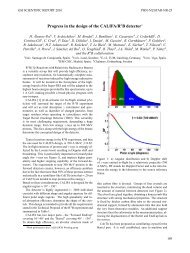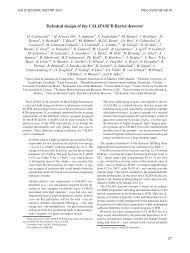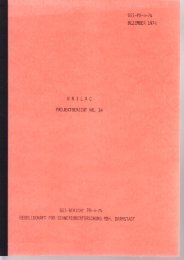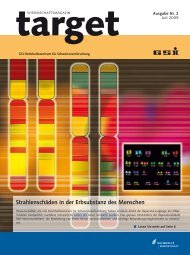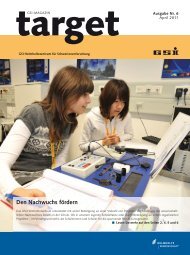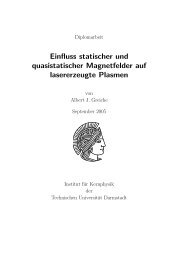download block - GSI Helmholtzzentrum für Schwerionenforschung
download block - GSI Helmholtzzentrum für Schwerionenforschung
download block - GSI Helmholtzzentrum für Schwerionenforschung
Create successful ePaper yourself
Turn your PDF publications into a flip-book with our unique Google optimized e-Paper software.
<strong>GSI</strong>-ACCELERATORS-14 <strong>GSI</strong> SCIENTIFIC REPORT 2009<br />
142<br />
Charge-Frequency-Converter (QFW) Test Board and Results<br />
H. Flemming**, S. Löchner**, H. Reeg*, M. Witthaus*, <strong>GSI</strong>, Darmstadt, Germany<br />
Overview<br />
<strong>GSI</strong> Beam Diagnostics department recently started<br />
investigations on an economic solution for profile grid<br />
electronics. The front-end amplifiers and control devices<br />
presently used are outdated, very expensive and important<br />
parts, like low noise amplifiers, have long delivery times<br />
and/or have been discontinued by the manufacturer.<br />
For the FAIR beamlines, around one hundred profile grid<br />
systems will be needed. The QFW CMOS-ASIC (Charge-<br />
Frequency-Converter [1][3]), developed by the Experiment<br />
Electronics department (EE) is a very promising<br />
candidate for a new design of the profile grids, due to it’s<br />
high dynamic range without the need for any range<br />
switching.<br />
After first tests with the 4-channel QFW module [2], it<br />
was decided to develop a new board, more related to<br />
practice and with additional electronic features (Fig. 1).<br />
Fig. 1: New QFW-board with PIC micro-controller,<br />
display LEDs, current divider, LVDS-/LV-TTL-drivers.<br />
Hard- and Software<br />
The experimental board shown in Fig. 1 consists of:<br />
• 4-channel QFW II<br />
• current divider (for extended measuring range)<br />
• LVDS- or LV-TTL outputs drivers<br />
• power-supply for external devices (+3.3V/+5V)<br />
• ICD-interface<br />
• two precision voltage sources<br />
• micro-controller Microchip® PIC 18FL4520<br />
• several LEDs, hex-switch and two push-buttons<br />
This board was designed in order to check the QFW in<br />
different operational modes, thus enabling measurements<br />
in the experimental areas of <strong>GSI</strong>. It was negotiated<br />
between Bio-Physics dept. and EE to add a selectable<br />
current divider onto the board, making it possible to<br />
measure currents up to 20 mA, of course dependent on the<br />
values of the circuit elements. Free-programmable LEDs,<br />
push buttons, a hex-switch and several I/O channels allow<br />
for adoption of the board to different measurement tasks.<br />
*Beam Diagnostics ** Experiment Electronics<br />
Output pulses and overload-bits are fed to their connector<br />
plugs through LVDS- or LV-TTL-drivers.<br />
The micro-controller software was programmed in<br />
assembler via Microchip MPLAB®. The hex-switch<br />
allows changing range and polarity. After Power-On or<br />
Reset with the related buttons, the micro-controller<br />
transfers the necessary instructions to the QFW interface,<br />
whereupon operation starts.<br />
Measurement Results<br />
The QFW was tested under different conditions. At first<br />
the agreement with the results from the QFW datasheet<br />
and jitter behaviour was checked, and then tests under<br />
different ambient temperatures and different levels of Xradiation<br />
were carried out (see [4] for more information).<br />
A jitter around 0.1 ppt or better at each particular current<br />
value was detected by using an HP time interval analyser<br />
5372A.<br />
The linearity of the frequency outputs fulfils the<br />
requirements for future profile grid electronics. Also the<br />
frequency deviation between each channel and a reference<br />
signal was investigated. This deviation is better than 1 %<br />
Full Scale.<br />
The temperature behaviour studies were performed in a<br />
climatic exposure cabinet. Many measurement series were<br />
done between 0°C and 50°C. The results show a deviation<br />
of 0.7 % only, with respect to the 20°C reference.<br />
Presently, all these results show that the QFW ASIC can<br />
be used in a new design for profile grid electronics.<br />
Additional comprehensive tests are in progress.<br />
Outlook<br />
A new QFW board equipped with 8 ASICs will be<br />
developed in 2010, in collaboration with the EE<br />
department. This prototype will be controlled by an<br />
existing FPGA-I/O VME board (VUPROM) .<br />
A LabVIEW program will control the measurements.<br />
First beam tests of the prototype will be performed with a<br />
2x16-wire profile grid in an experimental beamline at<br />
<strong>GSI</strong>. The board will also be used for further<br />
characterisation of the QFW ASIC.<br />
References<br />
[1] H. Flemming, QFW II Preliminary Datasheet, <strong>GSI</strong>,<br />
2008<br />
[2] H. Flemming, QFW Module Preliminary Datasheet,<br />
<strong>GSI</strong>, 2007<br />
[3] H. Flemming, E. Badura, A High Dynamic Charge to<br />
Frequency Converter ASIC, <strong>GSI</strong> Scientific Report, 2004<br />
[4] S. Löchner, Total Ionising Dose Studies of the QFW<br />
ASIC, <strong>GSI</strong> Scientific Report, 2009.





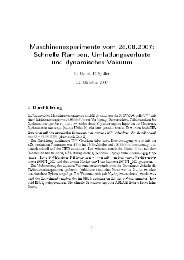
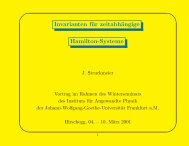
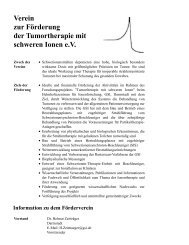
![GS I -P-]-17 - GSI Helmholtzzentrum für Schwerionenforschung](https://img.yumpu.com/20698964/1/184x260/gs-i-p-17-gsi-helmholtzzentrum-fur-schwerionenforschung.jpg?quality=85)

